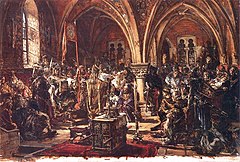
Back Сойм Каралеўства Польскага Byelorussian Σέιμ του Βασιλείου της Πολωνίας Greek Diète du royaume de Pologne French Sejm Kerajaan Polandia ID Lenkijos karalystės Seimas Lithuanian Sejm Korony Królestwa Polskiego Polish Сейм Королевства Польского Russian Сејм Краљевине Пољске Serbian Сейм Королівства Польського Ukrainian
Sejm of the Kingdom of Poland Sejm Królestwa Polskiego | |
|---|---|
| Kingdom of Poland | |
 | |
| Type | |
| Type | Bicameral (since 1493) |
| Chambers | Senate Chamber of Deputies |
| History | |
| Established | 1386 (1493) |
| Disbanded | 1569 |
| Preceded by | Curia Regis (wiec) |
| Succeeded by | Sejm of the Polish–Lithuanian Commonwealth |
| Leadership | |
Sigismund II Augustus since 1548 | |
Stanisław Sędziwój Czarnkowski since 1569 | |
| Meeting place | |
| Royal Castle, Warsaw | |

The General Sejm (Polish: Sejm walny, also translated as the General Parliament) was the parliament of the Kingdom of Poland. It had evolved from the earlier institution of Curia Regis (King's Council) and was one of the primary elements of democratic governance in the Polish dominion.
Initially established in 1386, it officially functioned as a bicameral diet since the formation of the Senate in 1493. The Sejm was composed of members of the royal council or king's court (the royal court, who played the largest role), provincial crown offices such as castellans, voivodes and higher nobility or magnates (the aristocratic element represented by the senate, upper house), members of the nobility who did not hold any crown offices and city council representatives (the democratic element represented by the lower house or chamber of deputies). These were the so-called three parliamentary states: the king, the senate and the parliamentary chamber. The Sejm was a powerful political institution, and from early 16th century, the Polish king could not pass laws without the approval of that body. The Sejm of Poland and the Seimas of the Grand Duchy of Lithuania were merged into the Sejm of the Polish–Lithuanian Commonwealth by the Union of Lublin in 1569.
Duration and frequencies of the sejms changed over time, with the six-week sejm session convened every two years being most common. Sejm locations changed throughout history. The number of sejm deputies and senators grew over time. Sejms have seen mostly majority voting.